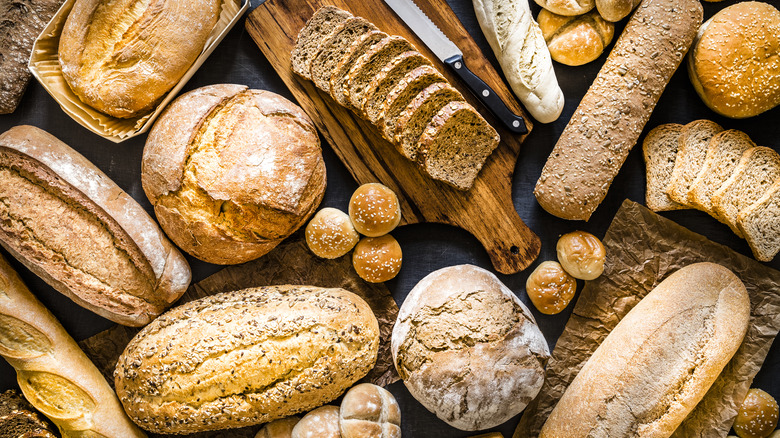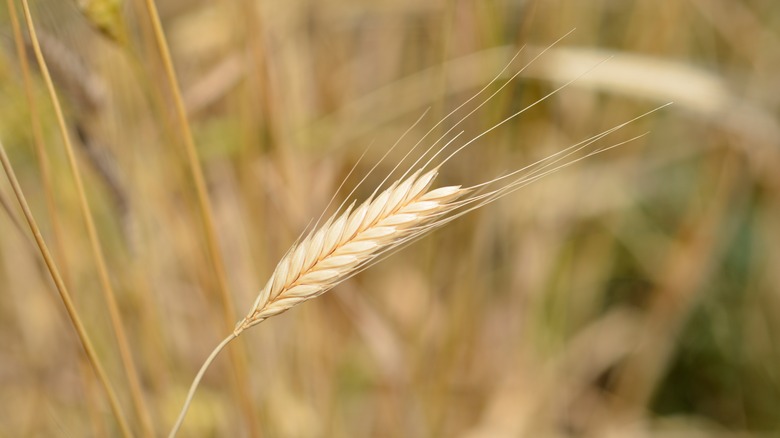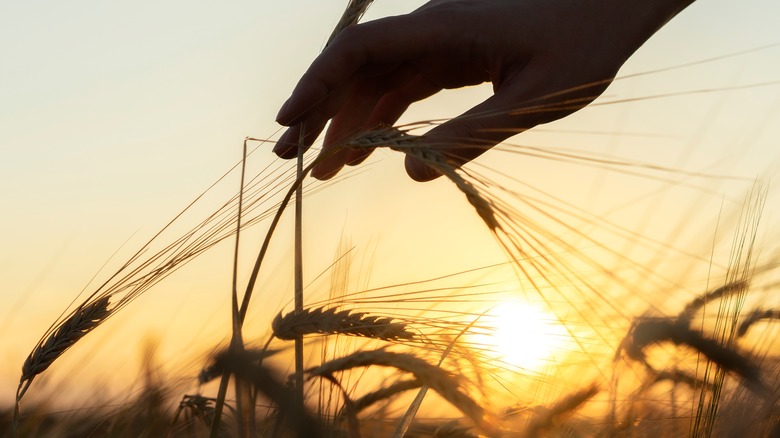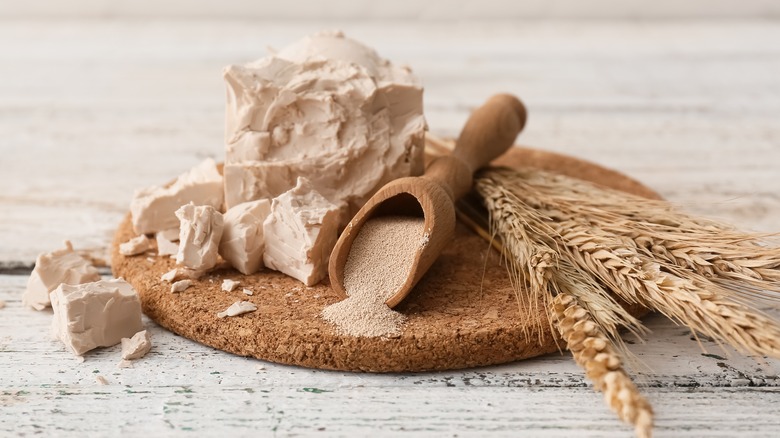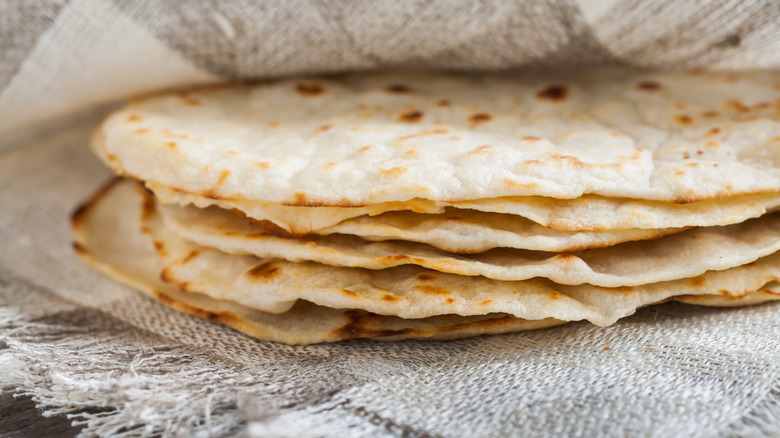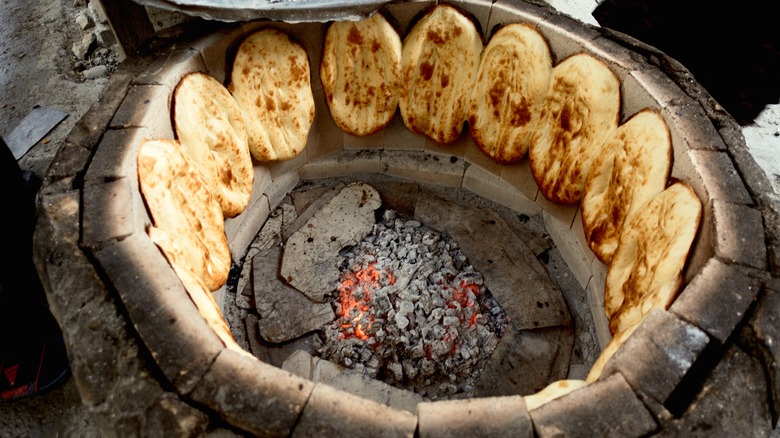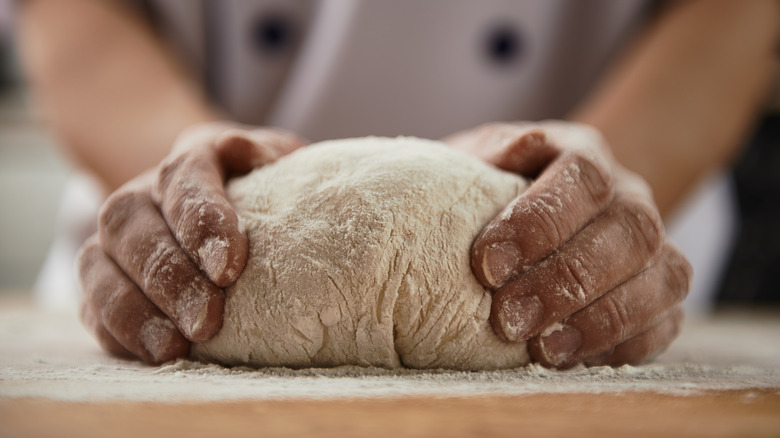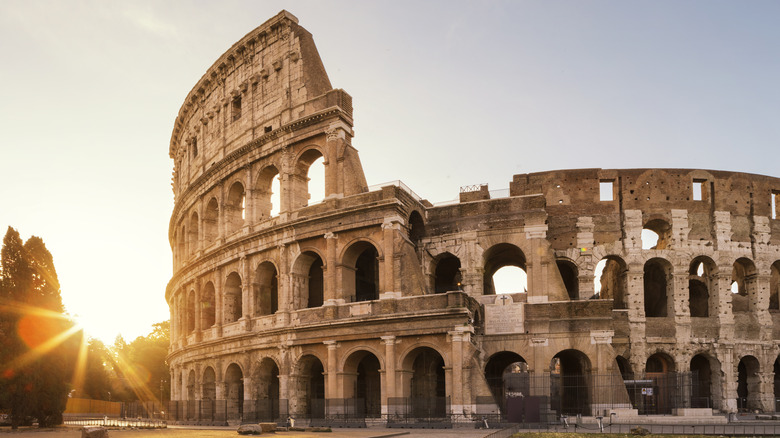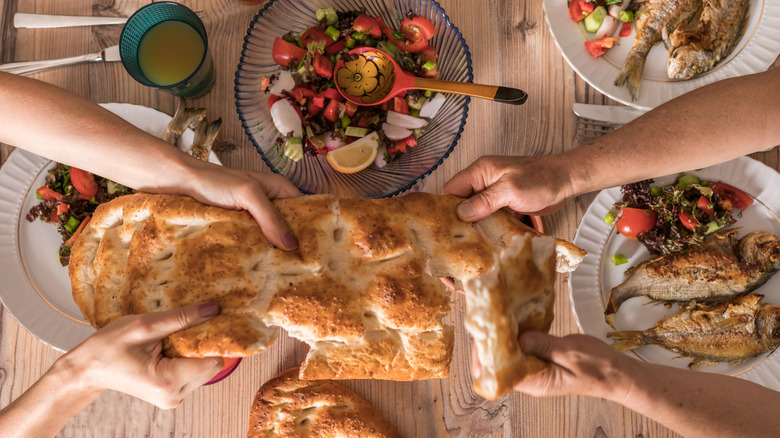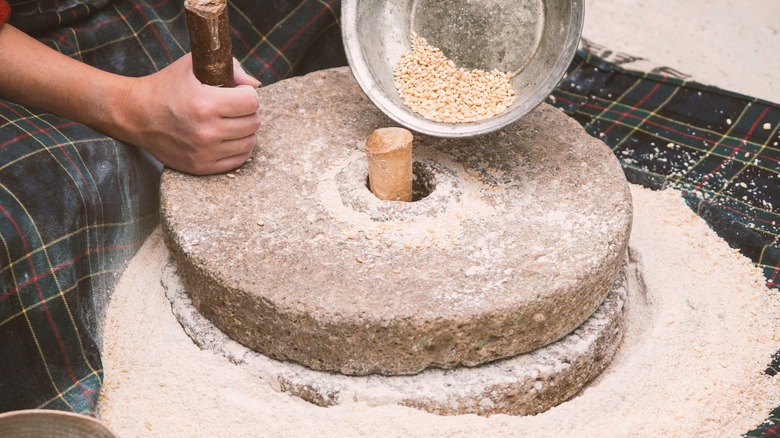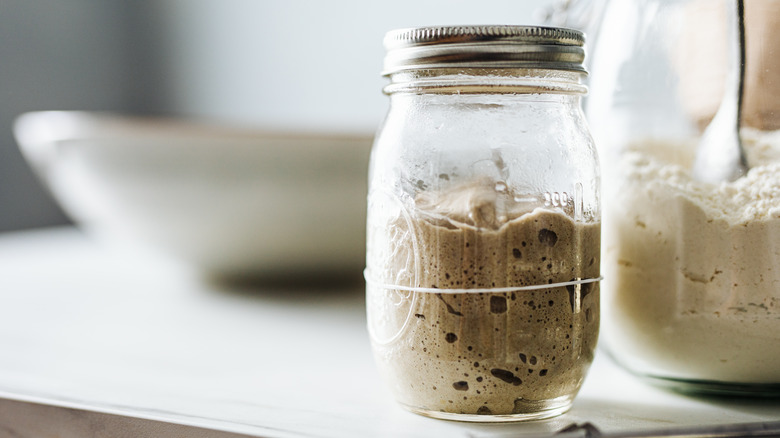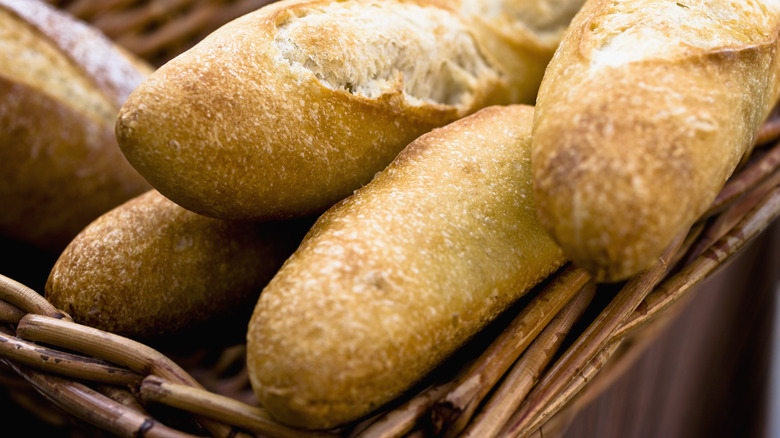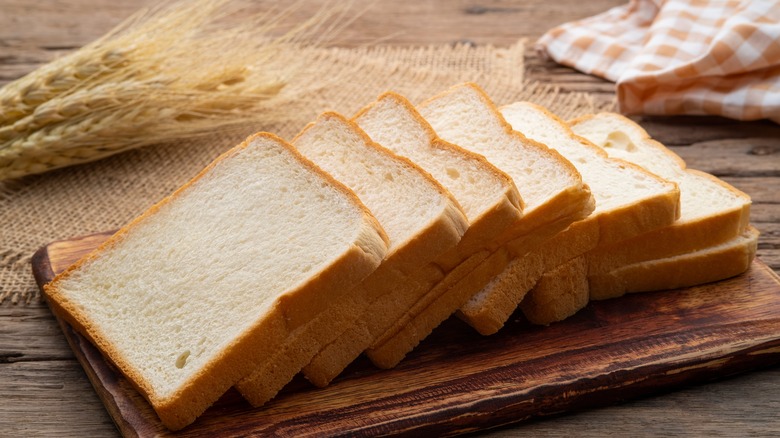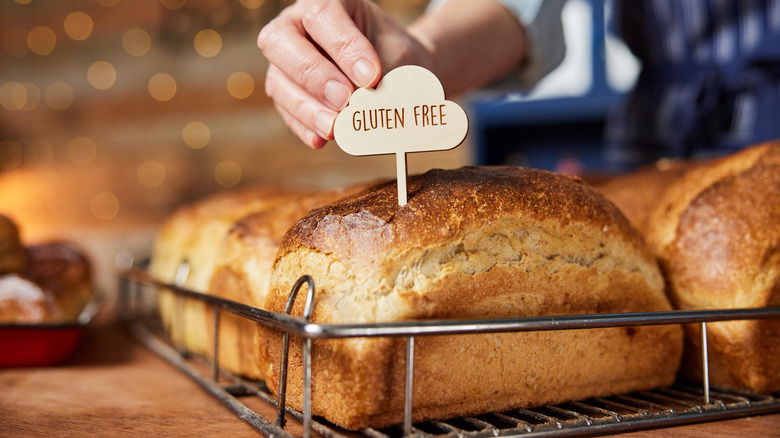The Complete History Of Bread
What is bread? After all, it comes in many forms. From arepas to challah to baguettes to youtiao to injera, you can find bread on every continent in just about every country. So, again, we ask, what is bread? According to the dictionary, at its core, bread is a baked mixture of water and flour. A bread recipe can be simple or complex (just take a look at all these hacks for baking bread!) The food itself is both revered and vilified. If nothing else, bread is anything but boring.
How did this staple food come to be? Bread is literally prehistoric, and because of that, its origins are still shrouded in a bit of mystery. Still, we can untangle quite a bit about the strange untold history of bread. From the root of wheat to the history of gluten-free baking, keep reading to learn (almost) all there is to know about the beginnings of this delicious food.
The ancient ancestors of wheat
Before there was modern-day wheat, there was wild einkorn (Triticum monococcum) and emmer (Triticum dicoccon). Known as "wheat's earliest ancestors," people began using them about 75,000 years ago, pre-agriculture. These grains grew taller than modern wheat — about 6 feet tall as opposed to 2 to 3 feet today. Remnants of ancient einkorn have been found in Central Asia and Europe. By the way, einkorn still grows today, and you should be using it in your bread.
In the early 2000s, researchers found a 22,000-year-old grinding stone and evidence of barley in an ancient settlement in Galilee. At the time, this finding was considered the oldest evidence of humans processing grains. However, a decade later, research showed that a stone found in a Southern Italian cave dating back 32,000 years ago, may have been used to grind grains. Scientists speculate people heated the grains and then ground them with the stone.
Domestication of wheat in the Fertile Crescent
People domesticated modern wheat in the Fertile Crescent about 10,000 years ago. Wheat grows well in the Mediterranean due to its temperate climate. The Natufians, a Levantine society credited with pioneering the transition from hunting and gathering to agriculture, are considered the first to make bread. As food historian William Rubel told Live Science, "The Natufians had the infrastructure for grinding barley and then making it into bread." The Natufians' bread was unleavened and resembled pita bread.
From the Fertile Crescent, wheat production spread worldwide. Today, most wheat is either hexaploid wheat (Triticum aestivum L.) or tetraploid wheat (Triticum durum Desf) — of which there are more than 25,000 varieties! Wheat is a staple of many diets and not just in the form of bread. Farmers worldwide have adapted wheat to grow in various environments, including subtropical. Despite a recent global wheat shortage, people on almost every continent cultivate wheat today. As of 2023, the top wheat-producing countries are China, India, and Russia.
Discovery of yeast
Yeast itself has an untold truth. The word yeast originally referred to the foam and not the organism itself. That wasn't until the 19th century when a Dutchman named J. H. van den Broek singled out the microorganisms. Many people credit Broek with discovering yeast, but archaeology shows people have been using it for thousands of years, even if they weren't opening up a package of yeast from the grocery store, and adding it to premeasured cups of flour the way we do today.
People have been fermenting things for millennia. And while that may be true due to genomic evidence, archaeologists believe Saccharomyces cerevisiae (beer and bread yeast) originated in China and moved westward. Yeast's recorded use in breadmaking isn't quite as old, though its actual history could be more ancient than what we have on paper. There are records of yeast's use in bread in Ancient Egypt (1300 to 1500 B.C.E.) and China (500 to 300 B.C.E.).
Discovery of the first baked bread
The origins of what we'd call bread are still murky. That said, historians currently credit Natufians with making the first bread. In 2018, scientists recovered remains of this bread that are likely 14,400 years old. They determined that the Natufians used einkorn wheat and club-rush tubers to make a dough they cooked in their fireplaces. It is said to have been unleavened and pita-like. Even with this evidence, it's not likely that breadmaking was common during this time period. The Natufians were still a society in transition into agriculture, and it wasn't until agriculture was the primary method of food production that cereal-based foods became staples.
By 8000 B.C.E., for example, it was clear that Egyptians were regularly eating unleavened bread, similar to the modern-day tortillas of Mexico. Over the next thousand years, people honed the bread production process, and it eventually became the staple it is today.
The use of vertical clay ovens
Vertical clay ovens are known by many names, including tannur, tandoor, or tandir, and are still in use today. People in the Indus Valley (modern-day India and Pakistan) used them 5,000 years ago, and the Natufian breadmakers of 14,400 years ago used their own versions of them. Vertical ovens can be underground or above. The oven is like a fireplace in that the heat source is inside its thick walls, and the hole at the top acts as a chimney. Besides that, these ovens differ from conventional Western ones in that the bread is stuck to the inside of them. This construction allows the bread to cook without the use of much fat.
Items in these ovens also cook quickly, as the vertical oven can reach as hot as 900 degrees Fahrenheit. This lends the bread its signature smokiness. Of course, bread isn't the only food cooked in a vertical oven. Tandoori meats are also extremely popular. And while it's not technically made in a vertical oven (unless you have one), this easy tandoori chicken recipe goes great with naan.
History of using yeast in bread
While people have been making bread and using yeast for a long while, the pairing of bread and domesticated yeast came together around 1000 B.C.E. At least, that's what some scholars think. Others say that yeasted bread came to be around that same time but in Mesopotamia. In any case, food historian Howard Miller told LiveScience that "Beer is liquid bread ... They have the same ingredients — water, grain, yeast — just in different proportions." It's possible Egyptians made and used early yeasted bread to make beer, first by making the bread, and then fermenting it in water.
Even still, others say that the Romans were the first to make yeasted bread — again around 1000 B.C.E. Is it possible that all of these civilizations just happened to come across yeasted bread around the same time? Sure, bread is a good idea, and sometimes different people have the same good idea independently of one another.
The truth behind Bread and Circuses
If you're a sci-fi or dystopian fan, you've likely heard the term "Bread and Circuses." The Latin phrase for it — panem et circenses — does, in fact, come from ancient Rome. The satirical poet Juvenal said, "Two things only the people anxiously desire — bread and circuses." He was complaining about people's lax attitude toward the failing democracy around them, which they allowed to be traded away for free food (actually bread) and entertainment. All of this happened back in the first century when Rome went from a democracy to an autocracy in just 100 years. We still use the term today, though it's usually less literal.
The phrase has come to mean situations where people give up political freedom in exchange for stability. Juvenal's original phrase and example have had such a lasting effect that it inspired the name of the nation's capital in the dystopian modern classic The Hunger Games.
The use of bread in spirituality
Bread has a history of being very important in religions, particularly Abrahamic ones. If you've ever used flatbread to break your Ramadan fast, had matzah at the Passover Seder, or had tsoureki at Easter, you know how inextricable bread is to some faiths. Often bread symbolizes food and its holiness, but also more. Take, for instance, the Catholic ostia or wafer that, to practitioners, transforms into the literal body of Jesus. The spirituality of the process can extend into the breadmaking process itself. Jews must, for example, set aside a portion of their bread dough to burn or bury to commemorate ancient temple offerings.
But it's not just the religions of today that have a special connection with bread. The ancient Greeks offered their deities bread, and the bread eaten by the Mesopotamian Enkidu is mentioned in The Epic of Gilgamesh. From a larger perspective of the grain world, we even see that tortillas and corn, more specifically, played a prominent role in Mayan history. Mayan creation mythology holds that the gods created people from corn.
Using machinery for milling grains
In 8000 B.C.E., Egyptians were making unleavened bread using a grinding stone called a quern, and the Romans were using a circular quern by 500 B.C.E. This simple machinery was the primary way people milled grains for centuries, especially in the Americas. In fact, "stoneground" flours are still ground this way. With the invention of weaving baskets and sieves, people were first able to separate ground wheat into bran and flour. After ancient Romans began to weave linen, they started to filter their flour through the fabric.
Even if most people were still grinding with stones, that doesn't mean everyone was. From the Roman Empire to the Byzantine Empire and the Western Han Dynasty, people were building mills of varying complexity. Throughout the 1600s and 1700s, gristmills (water-powered mills where grains are ground) finally began popping up around the United States. By the 19th century, they were common throughout the country.
San Francisco's influence on sourdough bread
Sourdough is the oldest type of leavened bread, and early breadmakers — likely in ancient Egypt — probably discovered it by accident. The bakers most likely left the dough out, and wild yeast sneaked in, looking for a snack. But Cairo is not the city famous for its sourdough — San Francisco is. So, what's the untold truth there? Well, pioneers already had their bread starters in their families for years. But those '49ers out for the Gold Rush discovered their bread tasted slightly different by the Bay. The foggy climate of the San Francisco Bay Area might not have been a great place to find gold, but it sure was a great place for wild yeast and bacteria to mingle and create a tangy loaf.
While the bacteria in sourdough aren't unique to the City by the Bay, it is Lactobacillus sanfranciscensis' namesake. If you're still not convinced sourdough isn't native to Northern California, check out these 16 types of sourdough bread and what makes them unique (spoiler alert: most aren't from California).
Commercial breadmaking in the 20th century
At the beginning of the 20th century, people learned that adding oxidants to bread dough quickens fermentation. Flour and yeast eat dioxides, which affect gluten structure and can also make a better product. In yeasted dough, yeast consumes the majority of oxidants; in unyeasted dough, the flour eats the majority.
There are two main types of commercial bread making: the first is bulk fermentation, and the other is mechanical dough development. In bulk fermentation, you first let the dough rise for a fixed amount of time (usually around two hours) and then divide it into loaves. It then rises once more before baking. In the second method, bakers add higher amounts of ingredients to the dough and mix the whole batch at a high speed. Doing this dramatically reduces the initial rise time (as little as 10 minutes). In New Zealand, for example, this is the primary commercial baking method.
Wonder Bread offers convenience to shoppers
You know the saying, "The best thing since sliced bread." But just when did "sliced bread" become the best thing? And whether it's the best is debatable, considering packaged bread can be unhealthy, especially white bread which can cause heart disease and diabetes (via Medical News Today). Wonder Bread, then owned by Indiana's Taggart Baking Company, first hit the market in 1921. It was one of the first prepackaged sliced breads available. The company used an ad campaign shrouded in wordplay and mystery to hype up interest in its product. Adspace that read, "WONDER? How often do you use this word every day? Check yourself," appeared in the local Indianapolis newspaper before the bread's debut.
Wonder Bread almost "died" several times in the 2010s, being shuffled around to different companies, but is now owned today by Flowers Foods. But that's not the only trouble that's plagued Wonder Bread through the years. In the 1950s and '60s, its makers touted the white slices as good for you because they contained 12 essential vitamins. The Federal Trade Commission didn't like that and required Wonder Bread to admit its bread wasn't healthier than others on the market.
The gluten-free diet and World War II
Many people might think gluten-free diets are a trendy fad that began sometime in the last 20 years. Not true. The origin of the gluten-free diet as we know it today began in World War II in a very tragic way. A Dutch pediatrician named Willem-Karel Dicke was already studying celiac disease in the 1930s, but his interest grew in 1944 when he saw what was called the "Hunger Winter." More than 4 million people were living off 500 to 1,000 calories a day or less. Over 20,000 died. Bread was one of the foods of which there was a shortage. And that's how Dicke realized the bread-celiac connection.
The kids in his cities who had already been diagnosed with celiac had improved health, even though they should have been getting worse under such a famine. His patients were even gaining weight. Just one year later when the famine was over and his patients had bread again, their health was once again poor. That observation set Dicke on a course to study the connection between wheat, gluten, and celiac disease.
